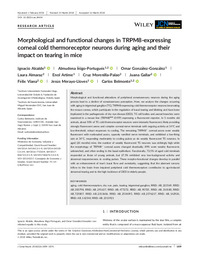Por favor, use este identificador para citar o enlazar este ítem:
https://hdl.handle.net/11000/5230Registro completo de metadatos
| Campo DC | Valor | Lengua/Idioma |
|---|---|---|
| dc.contributor.author | Alcalde, Ignacio | - |
| dc.contributor.author | Iñigo Portugués, Almudena | - |
| dc.contributor.author | González González, Omar | - |
| dc.contributor.author | Almaraz, Laura | - |
| dc.contributor.author | Artime, Enol | - |
| dc.contributor.author | Morenilla Palao, María Cruz | - |
| dc.contributor.author | Gallar Martínez, Juana | - |
| dc.contributor.author | Viana De la Iglesia, Félix | - |
| dc.contributor.author | Merayo Lloves, Jesús | - |
| dc.contributor.author | Belmonte Martínez, Carlos | - |
| dc.contributor.other | Departamentos de la UMH::Fisiología | es |
| dc.date.accessioned | 2019-07-08T10:51:32Z | - |
| dc.date.available | 2019-07-08T10:51:32Z | - |
| dc.date.created | 2018-03-16 | - |
| dc.date.issued | 2019-07-08 | - |
| dc.identifier.issn | 0021-9967 | - |
| dc.identifier.issn | 1096-9861 | - |
| dc.identifier.uri | http://hdl.handle.net/11000/5230 | - |
| dc.description.abstract | Morphological and functional alterations of peripheral somatosensory neurons during the aging process lead to a decline of somatosensory perception. Here, we analyze the changes occurring with aging in trigeminal ganglion (TG), TRPM8-expressing cold thermoreceptor neurons innervating the mouse cornea, which participate in the regulation of basal tearing and blinking and have been implicated in the pathogenesis of dry eye disease (DED). TG cell bodies and axonal branches were examined in a mouse line (TRPM8BAC-EYFP) expressing a fluorescent reporter. In 3 months old animals, about 50% of TG cold thermoreceptor neurons were intensely fluorescent, likely providing strongly fluorescent axons and complex corneal nerve terminals with ongoing activity at 348C and low-threshold, robust responses to cooling. The remaining TRPM81 corneal axons were weakly fluorescent with nonbeaded axons, sparsely ramified nerve terminals, and exhibited a low-firing rate at 348C, responding moderately to cooling pulses as do weakly fluorescent TG neurons. In aged (24 months) mice, the number of weakly fluorescent TG neurons was strikingly high while the morphology of TRPM81 corneal axons changed drastically; 89% were weakly fluorescent, unbranched, and often ending in the basal epithelium. Functionally, 72.5% of aged cold terminals responded as those of young animals, but 27.5% exhibited very low-background activity and abnormal responsiveness to cooling pulses. These morpho-functional changes develop in parallel with an enhancement of tear’s basal flow and osmolarity, suggesting that the aberrant sensory inflow to the brain from impaired peripheral cold thermoreceptors contributes to age-induced abnormal tearing and to the high incidence of DED in elderly people. | es |
| dc.description.sponsorship | This work was supported by grants FC-15-GRUPIN14–141 (Consejería de Economía y Empleo, Asturias, Spain), | - |
| dc.description.sponsorship | Fundación Ramón Areces, Caja Rural de Asturias, SAF2014–54518-C3-2-R, SAF2014– 54518-C3-1-R, SAF2017–83674-C2-2-R, SAF2017–83674-C2-1-R, | - |
| dc.description.sponsorship | SAF2016–77233-R (Ministerio de Economía, Industria y Competitividad, Spain and European Regional Development Funds, European Union) | - |
| dc.description.sponsorship | “Severo Ochoa” Program for Centers of Excellence in R&D (SEV-2013-0317). | - |
| dc.format | application/pdf | es |
| dc.format.extent | 16 | es |
| dc.language.iso | eng | es |
| dc.rights | info:eu-repo/semantics/openAccess | es |
| dc.subject | aging | es |
| dc.subject | cold thermoreceptors | es |
| dc.subject | dry eye | es |
| dc.subject | pain | es |
| dc.subject | tearing | es |
| dc.subject | trigeminal ganglion | es |
| dc.subject.other | Fisiología | es |
| dc.title | Morphological and functional changes in TRPM8-expressing corneal cold thermoreceptor neurons during aging and their impact on tearing in mice | es |
| dc.type | info:eu-repo/semantics/article | es |
| dc.identifier.doi | 10.1002/cne.24454 | - |
| dc.relation.publisherversion | https://doi.org/10.1002/cne.24454 | - |

Ver/Abrir:
2-Alcalde et al 2018 (TRPM8 aging).pdf
4 MB
Adobe PDF
Compartir:
 La licencia se describe como: Atribución-NonComercial-NoDerivada 4.0 Internacional.
La licencia se describe como: Atribución-NonComercial-NoDerivada 4.0 Internacional.
.png)